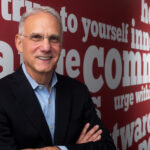Moving Beyond the Misdiagnosis of Polarization
Russia’s war of aggression has pulled America together to stand in solidarity with the Ukrainian people. But typically after these moments of unity — whether during a war, the early period of Covid, a natural disaster, or some other major event — public discourse devolves back into divisive rhetoric.
Conventional wisdom says that the reason our unity is fleeting is that Americans are polarized, leading to endless gridlock and festering problems.
But polarization is both a misdiagnosis and an excuse for why we seem unable to address the fundamental issues facing our country, and for why we plunge further into division once the glimmers of unity inevitably fade.
The Harwood Institute for Public Innovation, with the support of the American Communities Project, recently conducted 16 in-depth focus groups with Americans from cities and small towns, suburbs and rural areas, and a Native American reservation to find out the real state of our union today.
Our study, Civic Virus: Why Polarization Is a Misdiagnosis, reveals that Americans insist they are not polarized. Nor do they feel antagonistic toward their fellow citizens. I talked about the report with MSNBC’s Chuck Todd on Meet the Press Daily, who said, “It examines what might be at the heart of so much of what drives today’s toxic politics.” Here’s what’s we found:
-
People are separating and segregating themselves from one another due to unrelenting fear and anxiety about what’s happening around them and to them.
-
Many leaders, news media, and social media are intentionally stoking polarization for their own self-interest — producing a ceaseless surround sound that is engulfing people, subjecting people to an alternate reality that confuses, disorients, and destabilizes them.
-
Seeing no way out, people have an instinctive fight-or-flight response with many breaking up into smaller camps to protect themselves and gain validation, while others retreat from engaging at all.
Divisions in the country are intrinsically about social and psychological conditions — such as fear, anxiety, and isolation — rather than about ideological polarization.
When unity fades and divisive rhetoric returns, we see Americans have a very human reaction to the troubling cross-currents that undermine public life and their personal lives. They are in a perpetual state of fight or flight, only momentarily interrupted by passing events.
The good news is that while rhetoric about polarization locks us in, a different understanding of what’s happening unlocks a new path forward.
Let me be clear. The pursuit of unity, for its own sake, pushes aside real differences that as a society we need to work through. There are real differences in our nation.
If we want to rebuild the nation, then we need to move beyond the hollow rallying cry for unity. Seeking consensus is fruitless and a waste of time. Our task is to be much more practical and realistic about what it takes to move out of our current bind. We need to find targeted areas of agreement and begin working on things together.
An essential start is to reframe public discussion to focus on people’s shared aspirations about what we seek to create and stop tearing each other down. We must also bring people together across lines that have been used to divide. And we need to create more safe spaces so people can see and hear one another, instead of assuming the worst about each other’s intentions and beliefs. Only when people can talk about what they are for and what we seek to create, will they begin to regain a sense of possibility about moving forward.
While large-scale actions may be needed, they are unlikely to gain widespread support now. More progress is likely in our local communities, where we can start small, with achievable actions and concrete projects, and grow our efforts over time. That’s how we can get things rolling and restore people’s belief that they can get things done together.
I don’t just believe this is possible; wishful thinking won’t get us anywhere. I’ve seen this in my work with communities for over 30 years in hard-hit, even traumatized places like Flint, Michigan; Mobile, Alabama; and Newtown, Connecticut.
I’m seeing it right now in Reading, Pennsylvania; Lexington, Kentucky; and Clarksville, Tennessee — three communities that are moving forward on new community-driven education and community agendas at a time when acrimonious debates on such topics as critical race theory, school board elections, banning books, and masks signal nothing but division.
While each of these communities is very different in terms of its demographics, economics, and history, they created similar agendas for education that focus on such areas as the need for more mental health support for young people, after-school activities, teachers who look more like the community, and addressing inequities across schools, among others. These agendas show that people share common concerns about young people. And they demonstrate that by creating the right conditions, people can move beyond fight or flight and hot-button issues. Now, The Harwood Institute is launching the next phase of work in the communities to turn these agendas into concrete action. At the heart of this work is demonstrating how it’s possible amid the current challenging environment to take shared action and strengthen our civic culture.
It’s time to get beyond the false notion of polarization. But that requires taking practical steps that build a new trajectory of hope, one small step after another. There is no quick fix for the problems we face. Fight or flight is real, and we need meaningful responses to it if we seek to move our nation forward.
 Rich Harwood is President & Founder of The Harwood Institute for Public Innovation.
Rich Harwood is President & Founder of The Harwood Institute for Public Innovation.
